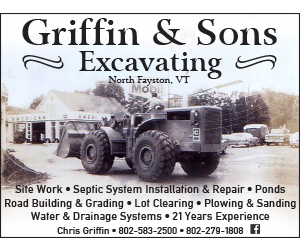Friends of the Mad River (FMR) partnered with Mad River Valley Arts (MRVA) to host a community event featuring the stories of local residents — a conservationist, a researcher, and a fishing guide – whose work deals intensely with water.
The Friday, December 6, 2024, event also featured poetry, commentary by local kids, and a visualization about how water flows, facilitated by FMR climate and engagement manager Luke Foley.
It was hosted at MRVA in Waitsfield, which is currently showing an exhibition called “Elemental,” featuring artworks from 20 artists about the global water cycle and its effects on human and non-human lives.
Rob Jordan, a Moretown-based fishing guide, told community members in the gallery that he started fishing as a kid – first in Pennsylvania where he grew up, then in Yellowstone National Park in Montana, where he got into fly fishing.
“I’ve always been connected to water,” he said, pointing to his astrological sign, Capricorn – a sign associated with a mythical creature that’s half goat, half fish.
Conservationist Kinny Perot, Warren, reflected on raising her family in Warren Village, with Freeman Brook in her backyard – an active part of the landscape. She recalled trying to catch a picnic table that belonged to her kids as it got away with the river’s current. She said she spotted it downstream three years later.
Perot is a board member of FMR – an organization she started in 1990, after she learned that Sugarbush Resort planned to create a snowmaking pond near the Mad River. She said she had nothing against the resort, but couldn’t make sense of putting an important piece of ski industry infrastructure in a location that would inevitably be affected by a meandering body of water. She formed a group to advocate for the river’s health and helped put together a conservation plan.
In between speakers, FMR watershed engagement coordinator Marcy Bucheit read a selection of haikus written by Ruth Lacey, Waitsfield, a citizen scientist who participates in FMR’s Mad River Watch Program – the longest-running volunteer-supported program of its kind in the United States, according to Bucheit.
For the past five years, Lacey wrote a haiku each time she collected water samples from Mill Brook. In 2022, she wrote:
Japanese knotweed
It’s everywhere but I
still see wildflowers
Rebecca Diehl, faculty in the Geography and Geosciences Department at the University of Vermont, also spoke. Trained as a fluvial geomorphologist, she studies, in part, how rivers move sediment across landscapes.
Diehl grew up visiting Vermont and said she spent a lot of time walking along creeks, intrigued by the ways that rivers sculpt land and habitats. As an undergraduate, she made rivers her object of study, eventually earning a PhD in watershed sciences. She did field observations of the Yampa River – a tributary of the Colorado River, to understand whether ecosystems would degrade due to river water being extracted in the context of drought.
She said one of the most inspiring aspects of her work is training generations of students to carry on watershed-related work.
Foley captured the spirit of a younger generation enthralled by waterways and the natural world more generally, in a video he showed audience members. In it, Moretown Elementary School students candidly describe how they appreciate fresh air, summer foliage, animal sightings, the old age of trees, and the abundance of fallen branches that can be used to build forts.
Regarding their observations of the natural world, one student excitedly told Foley, “It’s a reminder that we’re not the only living beings on the face of the earth.”
“Elemental” is on display at MRVA, at 5031 Main Street in Waitsfield, through Thursday, December 19, 2024.













